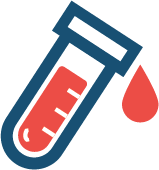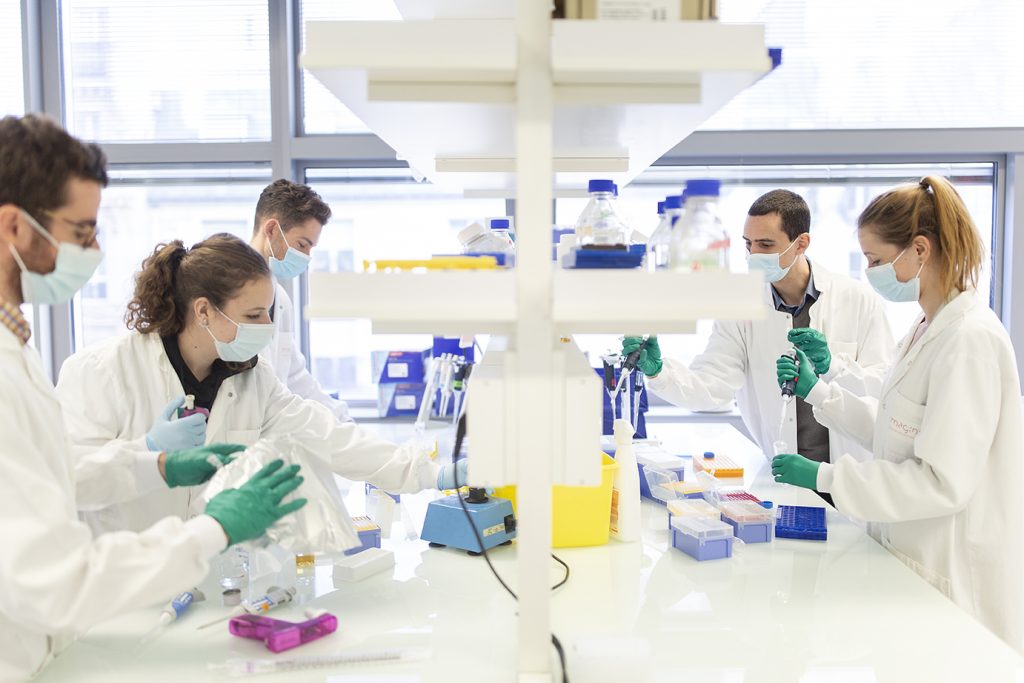Lab
Protocols


Detection of anti-cytokine autoantibodies (auto-Abs)
ELISA
ELISA
96-well ELISA plates (MaxiSorp; Thermo Fisher Scientific) are coated by overnight incubation at 4°C with 1 μg/mL rhIFN-α (Miltenyi Biotec, ref. number 130-108-984), rhIFN-ω (Peprotech, ref. number 300-02J) or rhIFN-β (Peprotech, ref. number 300-02BC). Plates are then washed (PBS/0.005% Tween), blocked by incubation with the same buffer supplemented with 2% BSA, washed, and incubated with 1:50 dilutions of plasma samples from the patients or controls for 2 h at room temperature (or with specific mAbs as positive controls). Horseradish peroxidase (HRP)–conjugated Fc-specific IgG fractions from polyclonal goat antiserum against human IgG (Nordic Immunological Laboratories) are added to a final concentration of 1 μg/mL. Plates are incubated for 1 h at room temperature and washed. Substrate is added and OD is measured. All incubation steps are performed with gentle shaking (600 rpm). A similar protocol is used when testing for the 12 subtypes of IFN-α.
Gyros
Gyros
Recombinant human (rh)IFN-α2 (Miltenyi Biotec, ref. number 130-108-984) was first biotinylated with EZ-Link Sulfo-NHS-LC-Biotin (Thermo Fisher Scientific, cat. number A39257), with a biotin-to-protein molar ratio of 1:12. Biotinylated rhIFN-α2 is used as a capture reagent at a concentration of 30 µg/mL. The detection reagent contains an Alexa Fluor 647 goat anti-human IgG secondary antibody (Thermo Fisher Scientific, ref. number A21445) diluted in Rexxip F (Gyros Protein Technologies, ref. number P0004825; 1/500 dilution of the 2 mg/mL stock to yield a final concentration of 4 µg/mL). PBS-T 0.01% buffer and Gyros Wash buffer (Gyros Protein Technologies, ref. number P0020087) are prepared following the manufacturer’s instructions. Plasma or serum samples are then diluted 1/100 in PBS-T 0.01% and tested with Bioaffy 1000 CD (Gyros Protein Technologies, ref. number P0004253) and Gyrolab X-Pand (Gyros Protein Technologies, ref. number P0020520). Cleaning cycles are performed in 20% ethanol.
Multiplex particle-based assay
Multiplex particle-based assay
Serum and plasma samples are screened for auto-Abs against 18 cytokine targets in a multiplex particle-based assay, in which magnetic beads with differential fluorescence were covalently coupled to recombinant human proteins. Patients with an FI of >1500 for IFN-α2 or IFN-β or >1000 for IFN-ω, and patients positive for another cytokine are all tested for blocking activity.
Evaluation of the neutralization activity of anti-cytokine auto-Abs: luciferase assay in HEK293T cells
Evaluation of the neutralization activity of anti-cytokine auto-Abs: luciferase assay in HEK293T cells
The neutralization activity of anti-IFN-α2, anti-IFN-ω and anti-IFN-β auto-Abs are determined by measuring reporter luciferase activity levels. HEK293T cells are transfected with a plasmid containing the firefly luciferase gene under control of the human ISRE promoter in the pGL4.45 backbone, and a plasmid constitutively expressing Renilla luciferase for normalization (pRL-SV40). Cells are transfected in the presence of the X-tremeGene9 transfection reagent (Sigma-Aldrich, ref. number 6365779001) for 24 hours. Cells in Dulbecco’s modified Eagle medium (DMEM, Thermo Fisher Scientific) supplemented with 2% fetal calf serum (FCS) and 10% healthy control or patient serum/plasma (after inactivation at 56°C, for 20 minutes) are either unstimulated or stimulated with rhIFN-α2 (Miltenyi Biotech, ref. number 130-108-984 (not glycosylated) or Merck, ref. number H6041-10UG (glycosylated)), rhIFN-ω (Peprotech, ref. number 300-02J (not glycosylated) or Origene, TP721113 (glycosylated)), at 10 ng/mL or 100 pg/mL (not glycosylated) or 1 ng/mL (glycosylated), or rhIFN-b (Peprotech, ref. number 300-02BC (glycosylated)) at 10 ng/mL or 1 ng/mL, for 16 hours at 37°C. Finally, cells are lysed for 20 minutes at room temperature and luciferase levels are measured with the Dual-Luciferase® Reporter 1000 assay system (Promega, ref. number E1980), following the manufacturer’s protocol. Luminescence intensity is measured with a VICTOR-X Multilabel Plate Reader (PerkinElmer Life Sciences, USA). Firefly luciferase activity values are normalized against Renilla luciferase activity values. These values are then normalized against the median induction level for non-neutralizing samples and expressed as a percentage. Samples are considered neutralizing if normalized luciferase induction (compared to Renilla luciferase activity) is below 15% of the median values for controls tested the same day. Reference
Evaluation of the neutralization activity of anti-cytokine auto-Abs: assessment of IFN-induced IP-10 production using whole blood samples
Evaluation of the neutralization activity of anti-cytokine auto-Abs: assessment of IFN-induced IP-10 production using whole blood samples
Fresh blood is collected in lithium heparin tubes (except when comparing lithium heparin, EDTA, and citrate tubes). The blood is stimulated with a serial 10-fold dilution of human glycosylated IFN-α2 (Merck, Catalog No.: H6041-10UG), IFN-β (Peprotech, Catalog No.: 300-02BC), IFN-ω (Origene, Catalog No.: TP721113), IFN-ε (Biotechne, Catalog No.: 9667-ME-025), IFN-κ (Cusabio, Catalog No.: CSB-YP889172HU), IFN-γ (IMUKIN) mouse IFN-α2 (R&D, Catalog No.: 12100-1) or cynomolgus monkey IFN-α2 (R&D, Catalog No.: 14110-1), or is left unstimulated (NS), in a final volume of 200 or 500 µL. After 16 h (or less in time-course experiments) of stimulation at 37 °C under an atmosphere containing 5% CO2, the plasma is collected and stored at −80 °C or used directly for the assessment of cytokine or chemokine production. The mAbs used as controls to block type I IFNs are preincubated with blood and used at a concentration of 3 µg/mL (anti-IFNAR2 mAb, PBL, Catalog No.: 21385) or a dilution of 1:50 (Human Type I IFN Neutralizing Antibody Mixture, PBL, Catalog No.: 39000). A total minimal volume of 1 mL is sufficient for the testing of a blood sample in all the above conditions. After whole-blood stimulation with IFN following the manufacturer’s protocol (R&D, Catalog No.: DIP100), IP-10 detection is performed by ELISA on the plasma supernatant.
